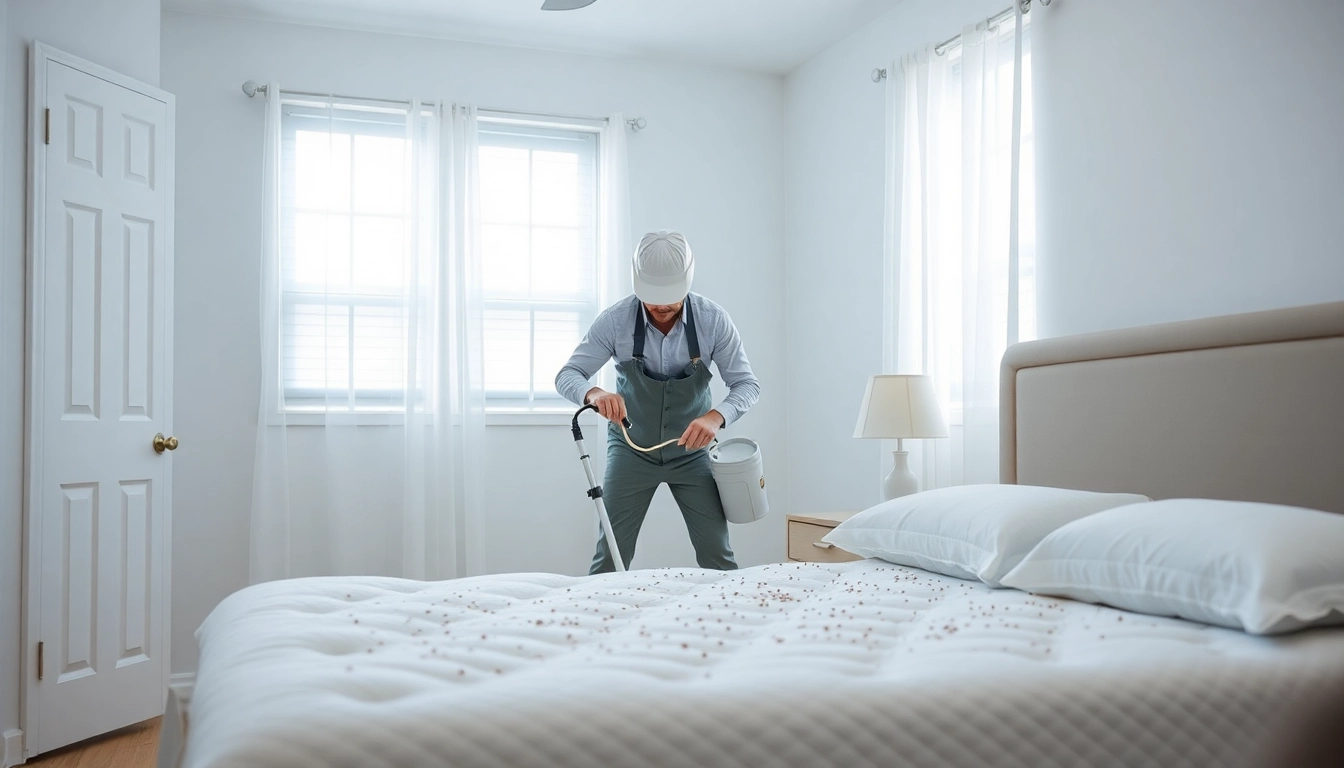Understanding Bed Bugs and Their Impact
Bed bugs, small parasitic insects that feed on the blood of humans and animals, have become a significant nuisance in households across the globe. These insects are not just a symptom of uncleanliness; they can invade even the most meticulously maintained homes. Their presence can lead to physical discomfort, anxiety, and financial burden due to the costs associated with their removal. For effective solutions for bed bug removal, it is crucial to understand who they are, the signs of their infestation, and the associated health risks.
What Are Bed Bugs?
Bed bugs (Cimex lectularius) are small, reddish-brown insects, approximately 4-5 mm in length, flat, and oval-shaped allows them to hide easily in crevices and folds. They thrive on warm-blooded hosts and are most active at night. Bed bugs reproduce quickly—females can lay hundreds of eggs during their lifespan of up to a year. They can survive for months without feeding, making them particularly hardy and hard to eliminate.
Signs of Infestation
Recognizing the signs of bed bug infestation early can save homeowners from significant distress and expenditure. Here are common indicators:
- Visible Bugs: Adults are about the size of an apple seed, while nymphs are smaller and lighter in color.
- Bed Bug Bites: These appear as red, itchy welts on exposed skin, often in a line or cluster. However, not everyone reacts to bites.
- Fecal Spots: Dark, small spots on sheets, mattresses, or walls indicate bed bug excrement.
- Egg Casings: Pale yellow shells can be found where eggs were laid.
- Musty Odor: A strong odor may be present when bed bugs are in high numbers, produced by pheromones.
Health Risks Associated with Bed Bugs
While bed bugs are not known to transmit diseases, their bites can lead to various health issues, including:
- Allergic Reactions: Some individuals develop severe allergic responses to bites.
- Secondary Infections: Excessive scratching can lead to open wounds which may become infected.
- Insomnia and Stress: The anxiety and discomfort caused by infestations can result in sleeplessness and emotional distress.
Methods for Bed Bug Removal
Effective bed bug removal can involve various strategies depending on the severity of the infestation. Homeowners can choose between DIY techniques or professional extermination services.
DIY Bed Bug Removal Techniques
Implementing a DIY approach can be effective, particularly for light infestations. Here are some recommended methods:
- Heat Treatment: Bed bugs can be killed by exposure to temperatures above 115°F (46°C). Use a clothes dryer on high heat for infested clothing and bedding.
- Vacuum Cleaning: Thoroughly vacuuming carpets, furniture, and crevices can help remove bugs and their eggs. Make sure to dispose of the vacuum bag immediately.
- Steam Cleaning: This method kills bed bugs on contact. Equip yourself with a steam cleaner that reaches at least 170°F (77°C).
- Diatomaceous Earth: This natural powder can be dusted in areas where bed bugs are likely to hide, causing dehydration upon contact.
While these methods can be effective, their success highly depends on diligence and thoroughness.
Professional Bed Bug Extermination Services
For more severe infestations, hiring a professional pest control service is often the best solution. Experts employ several methods, including:
- Integrated Pest Management (IPM): This approach combines various methods, including chemical and non-chemical solutions, to eradicate bed bugs efficiently.
- Pesticides: Professional exterminators have access to stronger, more effective pesticides that are not available to the general public.
- Heat Treatment: Technicians can utilize specialized equipment to heat entire rooms, ensuring that every nook is reached.
- Follow-Up Inspections: Professionals often provide follow-up inspections to ensure that no bed bugs are remaining after treatment.
Choosing the Right Removal Method
Deciding between DIY methods and professional services largely depends on the infestation’s size, budget, and urgency. For light infestations, DIY may suffice; however, persistent problems typically require professional assistance.
Preparing for Bed Bug Treatment
Preparation is key to maximizing the effectiveness of any bed bug removal strategy. The following steps will help ensure a successful treatment process:
Steps to Take Before Treatment
Before treatment begins, there are crucial preparatory actions to take:
- Identify Infested Areas: Determine the locations where bed bugs have been spotted or suspected to reside.
- Remove Clutter: De-clutter areas around beds and hiding spots to facilitate the exterminator’s job.
- Isolate Infested Items: Seal affected clothing and bedding in plastic bags to prevent the spread of bed bugs to uninfected areas.
Cleaning and Decluttering Your Space
Thorough cleaning before treatment is essential. This process includes:
- Washing Fabrics: Wash all bedding, curtains, and clothing in hot water (over 120°F) and dry them on high heat to eliminate bed bugs.
- Vacuuming: Vacuum your entire home meticulously, paying close attention to carpet edges, the seams of mattresses, and baseboards.
- Steam Cleaning: For carpets and upholstery, steam cleaning can further eradicate bed bugs and their eggs.
Safety Precautions During Treatment
During treatment, safety should be a priority:
- Evacuate the Area: Ensure all residents, pets, and plants are removed from treated areas, especially during chemical applications.
- Follow Expert Instructions: Adhere strictly to any guidance from pest control professionals regarding the duration of vacating the premises.
- Protect Yourself: Consider using masks and goggles if applying DIY treatment methods.
Post-Treatment Care and Prevention
After treatment, addressing follow-up care and preventive measures is crucial to avoid future infestations.
Monitoring for Remaining Bed Bugs
After treatment, continue to monitor for signs of bed bugs regularly:
- Inspect Frequently: Check commonly infested areas such as around beds and furniture monthly for a few months after treatment.
- Use Bed Bug Detectors: Consider purchasing mattress encasements and interceptors to trap and detect any remaining bugs.
Preventative Measures for Homeowners
To help prevent future infestations, implement the following strategies:
- Regular Cleaning: Maintain a routine cleaning schedule, including vacuuming and washing fabrics.
- Be Cautious When Traveling: Inspects hotel rooms upon arrival, keeping luggage off the floor and away from beds.
- Seal Cracks and Crevices: Regularly inspect and repair any potential areas where bed bugs might enter your home.
Utilizing Ongoing Professional Support
Establish a relationship with pest control professionals for ongoing support. Schedule periodic inspections, especially if you live in an area prone to bed bug infestations.
Cost Considerations for Bed Bug Removal
Understanding the costs associated with bed bug removal is vital for effective planning and budgeting.
Factors That Influence Treatment Costs
Several factors affect the cost of bed bug removal services:
- Infestation Severity: Heavily infested properties generally incur higher costs due to intensive treatment requirements.
- Location: Prices may vary based on geographical considerations—urban areas often have higher rates compared to rural locales.
- Method Used: The choice of treatment method (heat, chemical, or a combination) and the number of visits needed will influence the total price.
Cost Comparison: DIY vs. Professional Services
While DIY methods may appear cost-effective, they often result in inadequate solutions for higher infestations. Professional services, though more expensive upfront, tend to deliver faster and more reliable results. Consider long-term costs and potential re-infestation when weighing your options.
Financial Assistance and Resources
For those who may struggle with the costs associated with professional treatment, various resources exist:
- Local Outreach Programs: Many communities offer assistance for pest control for low-income residents.
- Payment Plans: Inquire with pest control services about financing options to help manage treatment costs.



